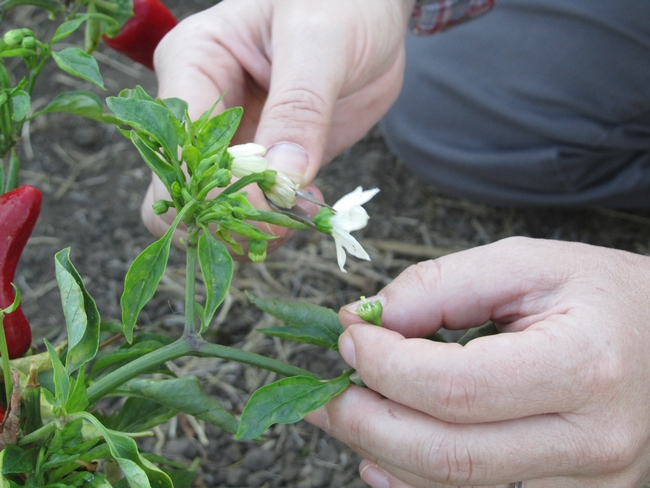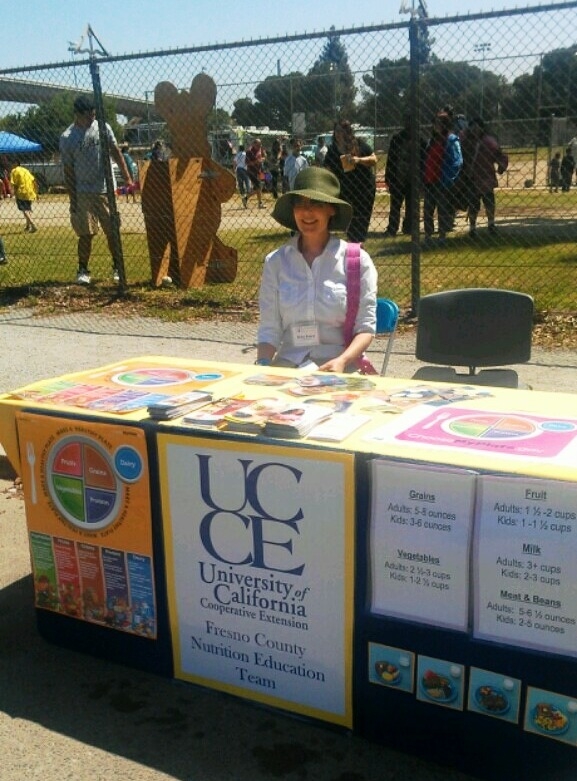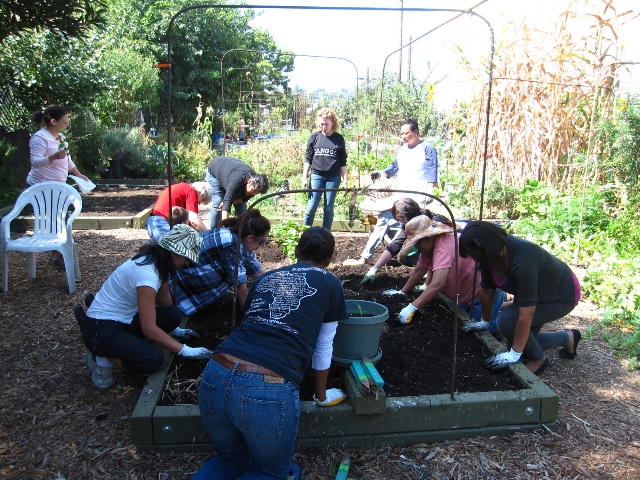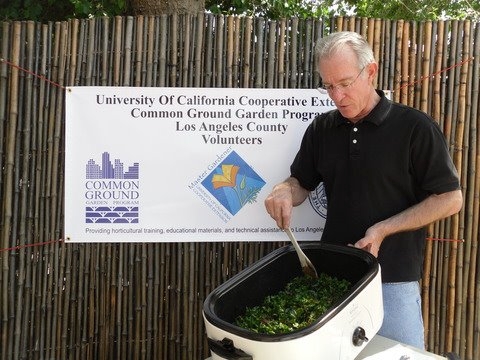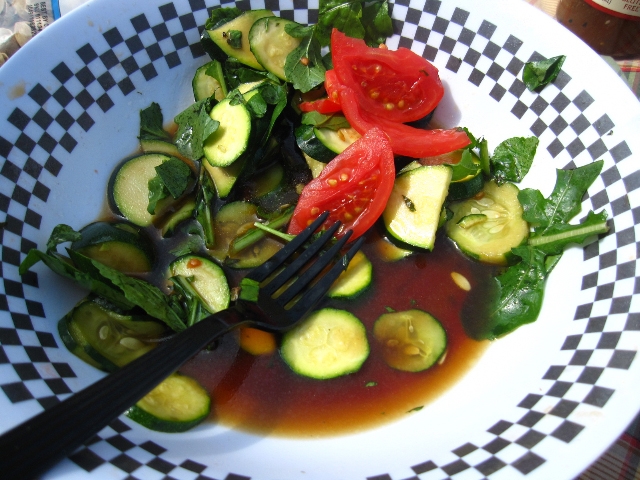UC Food Blog
Captivating capsicums: Igniting interest in plant breeding
Peppers in an array of colors, shapes, sizes and flavors grown at the UC Davis Student Farm are igniting interest in plant breeding and the astonishing botanical diversity of the Capsicum genus, to which all peppers belong.
“Fifty-two varieties is a wonderful candyland for me, but it’s just a few of the many varieties in the world,” said graduate student Ildi Carlisle-Cummins, who works on a partnership project between the Student Farm and researcher Allen Van Deynze.
Funded by the U.S. Department of Agriculture, the pepper project is meant to educate students and the general public about the importance of plant diversity and career opportunities in plant breading.
“Peppers make it easy because they leave such a strong impression,” said Carlisle-Cummins, who has been organizing field trips for students from second grade and up. “Students become fascinated with plant diversity and variety, and want to know more about molding and shaping it.”
While Carlisle-Cummins’ personal research is focused on sustainable food systems, she is delighted to explain cross pollination to show students how to develop new varieties of plants.
Plant breeding allows humans to select for certain desired traits, such as flavor, yield and pest resistance.
Agricultural has always been a dynamic, innovative industry, Carlisle-Cummins points out. Peppers originated in South America, in the region around modern day Bolivia. Over the centuries, a few species were taken by explorers all over the world. Farmers developed a kaleidoscopic array of subvarieties to suit their needs. Today, researchers are focused on developing new varieties to address new issues, like climate change.
“The world is changing,” Carlisle-Cummins said. “It’s pretty critical we have crops that can survive new places and climates and continue to feed us. It’s critical that we continue to inspire people to go into these fields of research so we have people who know how to work with plants, so they adapt along with a changing world.”
The chile pepper program continues throughout the year. Contact Ildi Carlisle-Cummins at icarlislecummins@ucdavis.edu to find out about upcoming events.
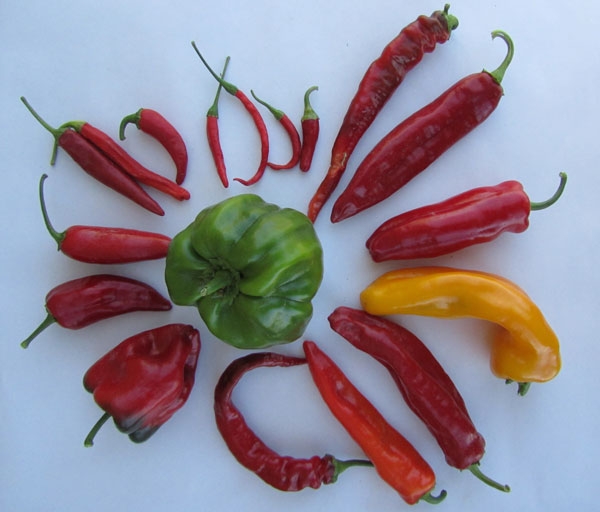
An array of peppers.
Yelp ratings give restaurants a boost
Every wonder whether those crowd-sourced reviews online actually make a difference in a business’s bottom line? For restaurants, the answer is an unequivocal yes, according to a new study by UC Berkeley economists. Researchers analyzed restaurant ratings on Yelp.com and found that, on a scale of 1 to 5 stars, a half-star rating increase translates into a 19 percent greater likelihood that an eatery’s seats will be full during peak dining times.
“This is the first study to link online consumer reviews with the popularity of restaurants,” said study lead author Michael Anderson, assistant professor in the Department of Agricultural and Resource Economics at UC Berkeley. “We show that social media sites and forums play an increasingly important role in how consumers judge the quality of goods and services.”
Anderson and study co-author Jeremy Magruder, also an assistant professor the Department of Agricultural and Resource Economics, analyzed 148,000 Yelp reviews for 328 restaurants in the San Francisco Bay Area. Their results, published this summer in the Economic Journal, did not take into account either price or service; they analyzed only the impact of positive Yelp reviews.
The study found that moving from 3 stars to 3.5 stars increases a restaurant’s chance of selling out during prime dining times from 13 percent to 34 percent, and that moving from 3.5 stars to 4 stars increases the chance of selling out during prime dining times by another 19 percentage points. These changes occur even though restaurant quality remains constant.
Not surprisingly, the economists found that crowd-sourced reviews have a bigger impact when there is a lack of alternative information available by which to judge a restaurant’s quality. They also found that restaurants rated in popular guidebooks or newspaper rankings did not see a statistically significant effect from the Yelp rankings.
“If a restaurant has a Michelin star or it appears in the San Francisco Chronicle’s list of Top 100 Restaurants in the Bay Area, the Yelp star becomes irrelevant,” said Magruder. “Those restaurants are relatively famous, and consumers already know them. For restaurants that were not on those established reviews, we actually saw a 27 percent greater likelihood in filled seats during peak dining times with a half-star rating increase on Yelp.”
Could these findings lead to potential manipulation of the ranking system for profit?
“We considered that possibility, and our study indicates that so far, such manipulation is under control,” said Anderson. “There are enough reviews available that it would be difficult to generate enough fake positive reviews to drown out the bad ones. There is also an element of self-policing since customers going to a restaurant on the basis of a good fake review only to be disappointed could submit a bad review. It could be hard for the business owner to sustain the false positives over time.”
The researchers are now looking to expand their analysis beyond eateries to sites such as Amazon.com, Tripadvisor.com and Netflix.com.
Volunteer educators help spread UC nutrition knowledge
Betsy Knapp, a former social worker, always knew that she loved helping people. But the experience of becoming a UC CalFresh Master Education Extender revealed her passion for nutrition education.
The Master Education Extender Team (MEET) was designed to recruit volunteers in the community and train them to extend UC CalFresh family-centered nutrition education in the community.
MEET is growing rapidly. Just nine months old, MEET has six active extenders who have delivered nutrition education based on USDA's MyPlate guidelines at various targeted community events and within Fresno Unified School District schools.
We have received a great response from interested community members whose backgrounds vary from pre-med students to UC CalFresh nutrition education series graduates. Fifteen new extender trainees are registered for our next quarterly orientation.
Betsy is now working for an endocrinologist and encouraging patients to eat healthy and to incorporate physical activity in their everyday lives.
“I believe that had I not volunteered with MEET, I never would have found this great job doing exactly what I love and was trained to do," Betsy said. "I don’t think people realize that MEET is a great opportunity for professional development. This program is needed in our community.”
To learn more about MEET or to complete an application to participate in the program, visit our website.
Insects, like restaurant customers, shape their wild plant menu
Restaurant patrons with their varied food preferences play a huge role in determining which food items are included on the menu. Now an international team of researchers, including a UC Davis plant scientist, is finding that plant-eating insects do much the same in the natural world, maintaining and shaping the genetic variation of their host plants in a geographic area.
The plant-grazing bugs accomplish this by forcing the plants to create diverse natural defenses to avoid being eaten, which in turn shapes the genetic makeup of the plants in a region. The researchers discovered this by studying aphids and the broccoli-like research plant Arabidopsis thaliana. Their findings provide the first measurable evidence that this selective process is driven, in part, by the pressure that multiple natural enemies exert on plants by forcing them to create diverse natural defenses to avoid being eaten.
“Our data demonstrate that there is a link between the abundance of two types of aphids and the continental distribution of Arabidopsis plants that are genetically different in terms of the biochemicals they produce to defend against insect feeding,” said UC Davis plant scientist Dan Kliebenstein.
His laboratory is examining the naturally occurring chemicals involved with plant defenses to better to understand their role in the environment and to explore their potential for improving human nutrition and fighting cancer.
Ecologists have theorized for decades that genetic change and variation within a plant or animal species is critical to enabling the species to survive changing environmental conditions like the appearance of a new disease or pest.
They have documented that nonbiological changes, such as variations in climate and soil, can exert pressures that cause genetic variation within plant species. However there has been little evidence that biological forces, including insects feeding on plants or competition between plant species, can lead to genetic variation within a plant species across a large geographic area.
In the new study, the researchers first mapped the distribution of six different chemical profiles within Arabidopsis thaliana plants across Europe, each chemical profile controlled by the variation in three genes.
The mapping revealed a change in the function of one of these key genes across geographic areas; the gene changed from southwest to the northeast.
The researchers suspected that two aphid species — Brevicoryne brassicae and Lipaphis erysimi — were the likely causes of the geographic variation. Both are abundant in the regions and feed heavily on Arabidopsis and related plants.
The scientists then tapped data collected by British researchers for nearly 50 years on fluctuations in aphid populations in Europe. They found that distribution of the two aphids species of interest closely mirrored the geographic distribution of the different chemical types of Arabidopsis plants. Like picky restaurant goers, one aphid preferred the southwestern chemical type while the other aphid preferred the northeastern chemical type.
The next step was to determine whether the similarity between the distribution patterns of the plants and the two aphid species was more than coincidental. To do this, the researchers observed what happened when the different aphids fed on five generations of experimentally raised Arabidopsis thaliana plants.
They confirmed that the plants were genetically adapting to the aphids, with each successive plant generation showing less damage from the feeding insects. A change in the genetic makeup of the plant populations specific to each aphid accompanied this trend — and the laboratory plants evolved in a way that tracked the geographic distribution of the two aphids and the plant chemical types.
The researchers also found that when faced with feeding by aphids, the faster-growing Arabidopsis plant types fared better in the laboratory, while the slowest-growing plant types actually went experimentally extinct.
“These data make it clear that even functionally similar plant-eating pests can affect the biochemical and genetic makeup of plant populations, playing a major role in shaping and refining the plant defenses in a natural community,” Kliebenstein said.
You’ll be able to read the complete report on this study, conducted with researchers in Switzerland, Denmark, England and the United States, will appear in the Oct. 5 issue of the journal Science.
Infusing nutrition education into an LA County vegetable garden initiative
Two weeks ago, my colleague wrote about LA County Cooperative Extension’s popular “Grow LA Victory Garden” initiative – Resources for beginning vegetable gardeners develop from LA initiative. This exciting initiative has achieved great success in LA County over the past two years by teaching more than 1,100 beginner gardeners how to grow their own vegetables at home through Master Gardener-led classes.
These classes impart an array of useful skills onto beginner gardeners, potentially translating into positive outcomes, such as improved diet and savings on groceries.
What to do with all of that home-grown produce?
Teaching novices how to grown their own food at home is one thing, but what are they going to actually do with all of that produce once it is harvested? Often a dilemma for beginner and experienced gardeners alike! This is where Fresh from the Garden comes into play.
With funding from the UC Agriculture Sustainability Institute - Sustainable Agriculture Research and Education Program, we were able to incorporate nutrition lessons and cooking demonstrations into the 4-week garden series by training Master Gardener volunteers to deliver Fresh from the Garden lessons into low-income community gardens. This is a resource that was designed to increase gardeners' knowledge of healthful eating habits, while emphasizing the health benefits associated with a vegetable-rich diet. Each Fresh from the Garden lesson features preparation and tasting of a healthy fresh vegetable recipe. Through these lessons, the beginner gardeners learned how to store, prepare and cook a wide variety of home-grown vegetables alongside the gardening instruction.
Reaping the benefits of vegetable gardening
We found that combined gardening, nutrition and cooking instruction encouraged novice gardeners to make important changes in their diets. By the end of the 4-week series, the participants said they were eating more servings of fruits and vegetables each day. What’s more, they were much more confident in their skills to prepare and cook home-grown vegetables. By the end of the 4-week series, 90 percent of participants surveyed said they could prepare and cook home-grown vegetables. This group was also very interested in trying different types of vegetables and all said they were willing to serve them to their families.
Through this project we have demonstrated promising results with the combination of gardening, cooking and nutrition instruction. We plan to continue the delivery of Fresh from the Garden in the coming year through the UC CalFresh Nutrition Education Program in coordination with the Master Gardener Program. CalFresh (formerly Food Stamp) participants are allowed to use their benefits to purchase seeds and plants for household consumption, which opens the door for exciting possibilities for this program!


